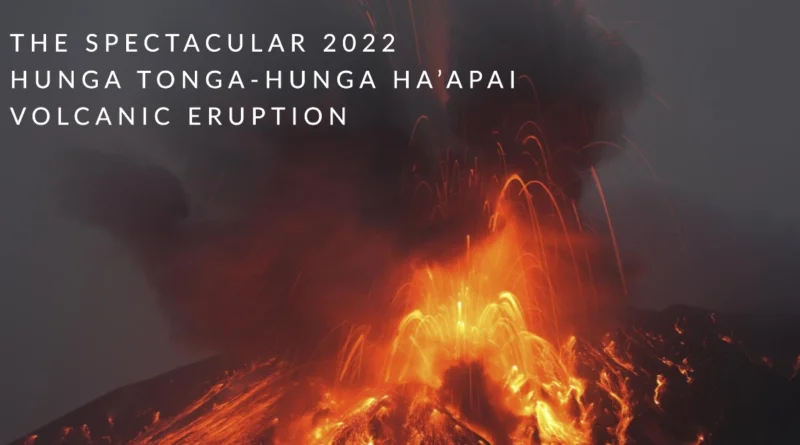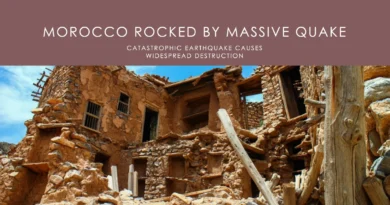The Spectacular 2022 Hunga Tonga-Hunga Ha’apai Volcanic Eruption: A Deep Dive
Introduction
In January 2022, the world watched in awe and trepidation as one of the most remarkable natural events of our time unfolded—the eruption of the Hunga Tonga-Hunga Ha’apai submarine volcano. Located near the island nation of Tonga in the South Pacific, this volcanic eruption captured global attention due to its sheer scale and impact.
This blog post takes you on a journey into the heart of this volcanic event, exploring the volcano itself, the eruption’s dramatic unfolding, its scientific significance, environmental consequences, technological disruptions, ongoing research, and what this all means for our understanding of Earth’s dynamic forces.
The Hunga Tonga-Hunga Ha’apai Volcano
Hunga Tonga-Hunga Ha’apai is a name that may not have been widely known before 2022, but it has since become synonymous with one of the most talked-about geological events in recent history. This volcanic complex is a submarine volcano, meaning it lies beneath the ocean’s surface. Its location in the Pacific Ocean near Tonga made it a relatively remote and unassuming feature until it roared to life.
Submarine volcanoes are unique and inherently fascinating geological formations. They are formed when molten rock (magma) rises from the Earth’s mantle and encounters the cold waters of the ocean. This collision between extreme heat and the frigid deep-sea environment can result in spectacular eruptions.
The Eruption Unleashed
The eruption of the Hunga Tonga-Hunga Ha’apai volcano in January 2022 was nothing short of spectacular. It began with a series of explosions that sent plumes of ash, steam, and volcanic gases high into the atmosphere. The ash cloud, reaching heights of up to 55 kilometers (34 miles), was visible from space. These initial explosions were accompanied by stunning visuals of lightning within the ash plume, a phenomenon known as volcanic lightning.
| Date | Event |
|---|---|
| January 13 | The eruption begins with massive explosions. |
| January 15 | A plume of ash and steam rises high into the atmosphere. |
| January 16 | A tsunami is generated, affecting coastal areas. |
| January 23 | Satellite imagery shows the creation of a new island. |
| February 4 | The plume reaches the stratosphere, affecting climate. |
| Ongoing | Scientists closely monitor the eruption’s aftermath. |
The eruption generated shockwaves that reverberated across the Pacific Ocean. Notably, the eruption also resulted in the creation of a new volcanic island, which temporarily connected the previously separate Hunga Tonga and Hunga Ha’apai islands.
The most dramatic consequence of the eruption was the formation of a tsunami that radiated outward from the eruption site. The tsunami waves traveled across the Pacific Ocean, affecting coastal regions as far away as the west coast of the United States. Fortunately, early warning systems were effective in minimizing casualties, but the event served as a stark reminder of the interconnectedness of our planet’s geological processes.
Scientific Significance
Volcanic eruptions are always of great interest to scientists, but the Hunga Tonga-Hunga Ha’apai eruption held special significance due to its unique nature as a submarine volcanic event. Here are some key aspects of its scientific importance:
- Rare Opportunity: Submarine volcanic eruptions are relatively rare and challenging to study due to their remote location beneath the ocean. The Hunga Tonga-Hunga Ha’apai eruption provided scientists with a unique opportunity to observe and document the dynamics of such an event.
- Volcanic Lightning: The occurrence of volcanic lightning within the ash plume was a striking feature of this eruption. Scientists are keen to understand the mechanisms behind this phenomenon, which is not fully understood.
- Impact on Climate: The eruption injected a significant amount of water vapor into the stratosphere. This had the potential to influence the Earth’s climate by contributing to the formation of stratospheric clouds, which can have a cooling effect on the planet.
- Tsunami Dynamics: Studying the tsunami generated by the eruption helps scientists better understand how these events propagate across the ocean. This knowledge can inform early warning systems and improve our ability to mitigate tsunami-related risks.
Environmental Impact
The eruption of the Hunga Tonga-Hunga Ha’apai volcano had several environmental consequences:
- Atmospheric Effects: The injection of water vapor and volcanic particles into the stratosphere can lead to the formation of sulfuric acid aerosols. These aerosols can scatter sunlight and contribute to a temporary cooling of the Earth’s surface.
- Marine Life: The eruption’s impact on marine life, particularly in the vicinity of the eruption site, is an ongoing area of research. Volcanic eruptions can release harmful chemicals into the ocean, affecting marine ecosystems.
- Tsunami Effects: The tsunami generated by the eruption led to localized coastal inundation and disrupted marine environments. The effects on coral reefs and coastal habitats are being studied.
Technological Fallout
One unexpected consequence of the eruption was the disruption of satellite communication and navigation systems. The injection of volcanic material into the stratosphere can affect the performance of satellites and the accuracy of GPS systems. This highlighted the vulnerability of our modern technological infrastructure to natural disasters.
Ongoing Research
Scientists continue to study the aftermath of the Hunga Tonga-Hunga Ha’apai eruption to gain insights into various aspects:
- Climate Implications: Research is ongoing to understand the longer-term climate effects of the eruption, including its impact on global temperatures and weather patterns.
- Environmental Resilience: Studies are being conducted to assess the resilience of marine ecosystems in the affected region and to monitor the recovery of coral reefs and other habitats.
- Volcanic Lightning: The mechanisms behind volcanic lightning remain a subject of interest, and scientists are working to unravel the physics of this phenomenon.
Conclusion
The eruption of the Hunga Tonga-Hunga Ha’apai submarine volcano in January 2022 was a breathtaking display of nature’s power. From the initial explosions and volcanic lightning to the creation of a new island and the far-reaching tsunami, this event showcased the dynamic and interconnected processes that shape our planet.
Scientifically, the eruption offered a rare opportunity to study submarine volcanic activity and its impact on climate and the environment. It served as a reminder of the importance of ongoing research into Earth’s geological forces and their consequences.
As we continue to grapple with the complex relationship between natural events and human technology, the Hunga Tonga-Hunga Ha’apai eruption underscores the need for preparedness, early warning systems, and a deeper understanding of our planet’s remarkable and sometimes unpredictable behavior.




